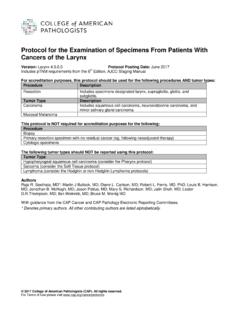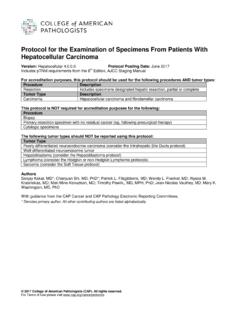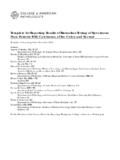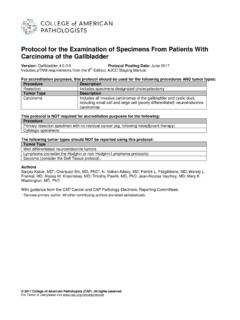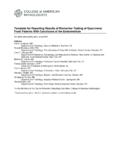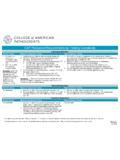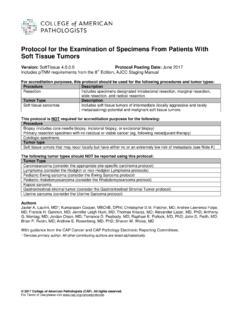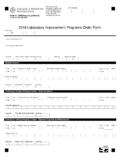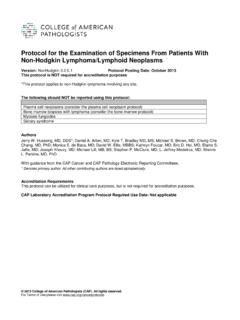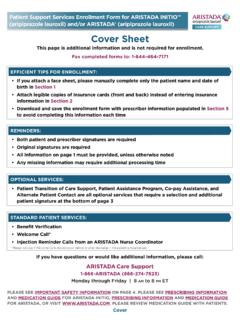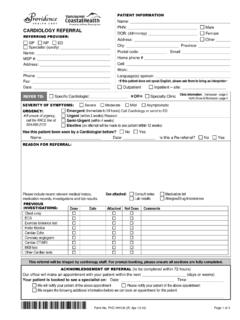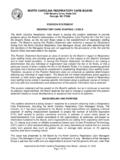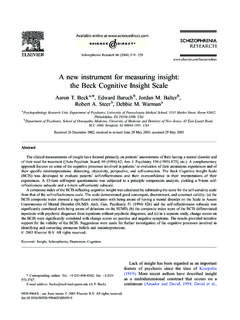Transcription of Protocol for the Examination of Specimens From …
1 Protocol for the Examination of Specimens From patients with primary Sarcoma of the Uterus Version: UterineSarcoma Protocol Posting Date: June 2017 Includes pTNM requirements from the 8th Edition, AJCC Staging Manual, and 2015 FIGO Cancer Report For accreditation purposes, this Protocol should be used for the following procedures AND tumor types: Procedure Description Resection Includes total hysterectomy and supracervical hysterectomy Tumor Type Description Sarcoma Includes leiomyosarcoma, adenosarcoma, endometrial stromal sarcoma, and undifferentiated uterine/endometrial sarcoma This Protocol is NOT required for accreditation purposes for the following: Procedure Biopsy, myomectomy, or removal of tumor in fragments primary resection specimen with no residual cancer (eg, prior myomectomy) Cytologic Specimens The following tumor types should NOT be reported using this Protocol .
2 Tumor Type Carcinoma (consider the Endometrium or Cervix protocols) Lymphoma (consider the Hodgkin or non-Hodgkin Lymphoma protocols) Authors Uma Krishnamurti, MD, PhD*; Saeid Movahedi-Lankarani, MD*; Debra A. Bell, MD; George G. Birdsong, MD; Charles V. Biscotti, MD; Christopher N. Chapman Jr, MD; Blaise Clarke, MD; Christopher P. Crumm, MD; Farnaz Dadmanesh, MD; Bojana Djordjevic, MD; Blake Gilks, MD; Alexandra N. Kalof, MD; Dina H. Kandil, MD; Veronica Klepeis, MD, PhD; Teri A. Longacre, MD; Alice Lytwn, MD; Catherine M. McLachlin, MD; Mariana J. Merino, MD; Anthony G. Montag, MD; Sharon L. Mount, MD; Marisa R. Nucci, MD; Christopher N.
3 Otis, MD; Peter J. Rossi, MD; Cornelia Trimble, MD; Zhaolin Xu, MD with guidance from the CAP Cancer and CAP Pathology Electronic Reporting Committees. * Denotes primary authors. All other contributing authors are listed alphabetically. 2017 College of American Pathologists (CAP). All rights reserved. For Terms of Use please visit Gynecologic Uterine Sarcoma UterineSarcoma Accreditation Requirements This Protocol can be utilized for a variety of procedures and tumor types for clinical care purposes. For accreditation purposes, only the definitive primary cancer resection specimen is required to have the core and conditional data elements reported in a synoptic format.
4 Core data elements are required in reports to adequately describe appropriate malignancies. For accreditation purposes, essential data elements must be reported in all instances, even if the response is not applicable or cannot be determined. Conditional data elements are only required to be reported if applicable as delineated in the Protocol . For instance, the total number of lymph nodes examined must be reported, but only if nodes are present in the specimen . Optional data elements are identified with + and although not required for CAP accreditation purposes, may be considered for reporting as determined by local practice standards.
5 The use of this Protocol is not required for recurrent tumors or for metastatic tumors that are resected at a different time than the primary tumor. Use of this Protocol is also not required for pathology reviews performed at a second institution (ie, secondary consultation, second opinion, or review of outside case at second institution). Synoptic Reporting All core and conditionally required data elements outlined on the surgical case summary from this cancer Protocol must be displayed in synoptic report format. Synoptic format is defined as: Data element: followed by its answer (response), outline format without the paired "Data element: Response" format is NOT considered synoptic.
6 The data element must be represented in the report as it is listed in the case summary. The response for any data element may be modified from those listed in the case summary, including Cannot be determined if appropriate. Each diagnostic parameter pair (Data element: Response) is listed on a separate line or in a tabular format to achieve visual separation. The following exceptions are allowed to be listed on one line: o Anatomic site or specimen , laterality, and procedure o Pathologic Stage Classification (pTNM) elements o Negative margins, as long as all negative margins are specifically enumerated where applicable The synoptic portion of the report can appear in the diagnosis section of the pathology report, at the end of the report or in a separate section, but all Data element.
7 Responses must be listed together in one location Organizations and pathologists may choose to list the required elements in any order, use additional methods in order to enhance or achieve visual separation, or add optional items within the synoptic report. The report may have required elements in a summary format elsewhere in the report IN ADDITION TO but not as replacement for the synoptic report all required elements must be in the synoptic portion of the report in the format defined above. CAP Laboratory Accreditation Program Protocol Required Use Date: March 2018* * Beginning January 1, 2018, the 8th edition AJCC Staging Manual should be used for reporting pTNM.
8 CAP Uterine Sarcoma Protocol Summary of Changes The following data elements were modified: Pathologic Staging Classification (pTNM) has been updated per AJCC 8th Edition. Additional revisions to this Protocol have been made to support the AJCC 8th Edition elements and prognostic factors important to the treatment of the patient. 2 CAP Approved Gynecologic Uterine Sarcoma UterineSarcoma Surgical Pathology Cancer Case Summary Protocol posting date: June 2017 UTERUS: Select a single response unless otherwise indicated. Procedure (select all that apply) ___ Total hysterectomy and bilateral salpingo-oophorectomy ___ Radical hysterectomy ___ Simple hysterectomy ___ Supracervical hysterectomy ___ Bilateral salpingo-oophorectomy ___ Right salpingo-oophorectomy ___ Left salpingo-oophorectomy ___ Salpingo-oophorectomy, side not specified ___ Right oophorectomy ___ Left oophorectomy ___ Oophorectomy, side not specified ___ Bilateral salpingectomy ___ Right salpingectomy ___ Left salpingectomy ___ Salpingectomy, side not specified ___ Omentectomy ___ Peritoneal biopsies ___ Peritoneal washing ___ Other (specify): _____ Note.
9 For information about lymph node sampling, please refer to the Regional Lymph Nodes section. + Hysterectomy Type + ___ Abdominal + ___ Vaginal + ___ Vaginal, laparoscopic-assisted + ___ Laparoscopic + ___ Laparoscopic, robotic-assisted + ___ Other (specify): _____ + ___ Not specified specimen Integrity ___ Intact ___ Opened ___ Morcellated ___ Other (specify): _____ Tumor Size Greatest dimension (centimeters): ___ cm + Additional dimensions (centimeters): ___ x ___ cm ___ Cannot be determined Histologic Type (select all that apply) (Note A) ___ Leiomyosarcoma ___ Leiomyosarcoma, epithelioid type ___ Leiomyosarcoma, myxoid type ___ Endometrial stromal sarcoma, low grade# + Data elements preceded by this symbol are not required for accreditation purposes.
10 These optional elements may be clinically important but are not yet validated or regularly used in patient management. 3 CAP Approved Gynecologic Uterine Sarcoma UterineSarcoma ___ Endometrial stromal sarcoma with smooth muscle differentiation, low grade ___ Endometrial stromal sarcoma with sex cord elements, low grade ___ Endometrial stromal sarcoma with glandular elements, low grade ___ Endometrial stromal sarcoma, high grade ___ Undifferentiated uterine/endometrial sarcoma ___ Adenosarcoma ___ Adenosarcoma with rhabdomyoblastic differentiation ___ Adenosarcoma with cartilaginous differentiation ___ Adenosarcoma with osseous differentiation ___ Adenosarcoma with other heterologous element (specify).
